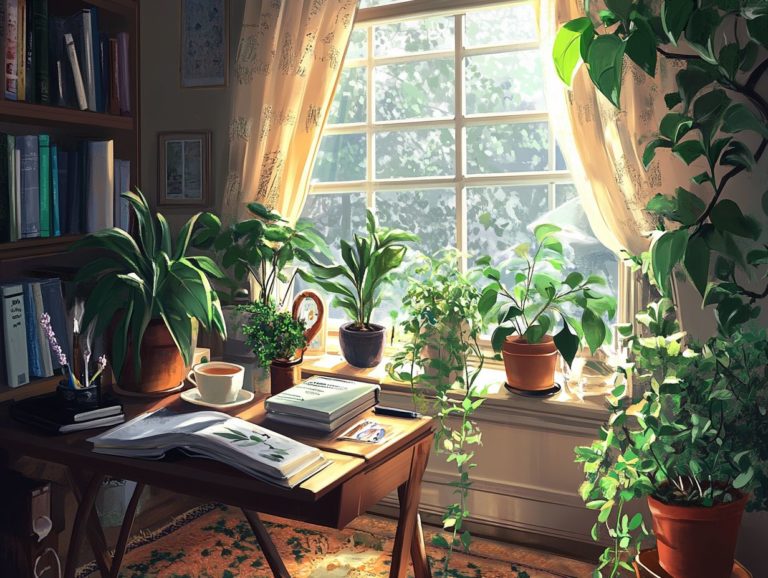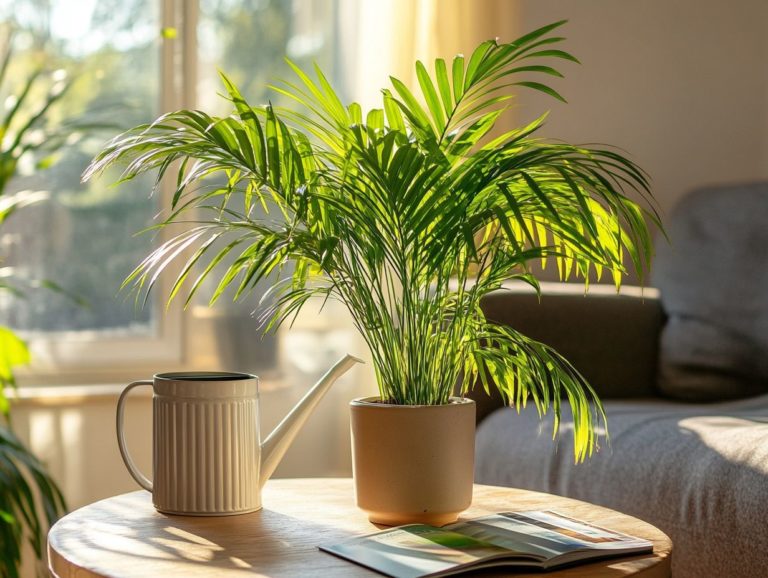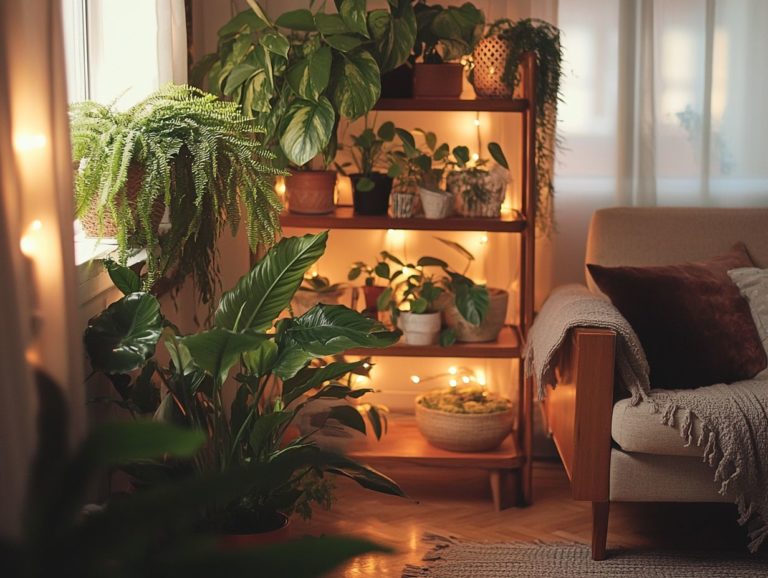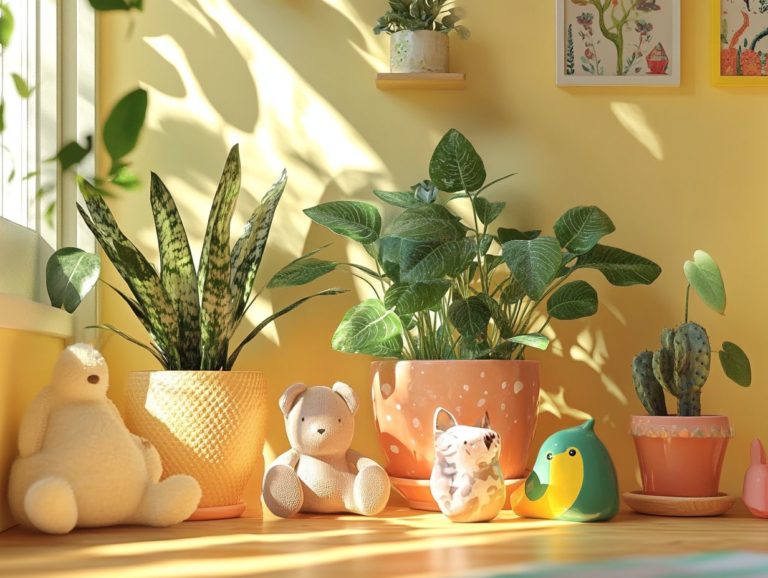A Guide to Caring for Indoor Bamboo
Indoor bamboo, particularly Lucky Bamboo, is an enchanting addition to your home, infusing it with a touch of nature and tranquility. It serves as an ideal indoor plant that brings luck.
This guide delves into the diverse varieties of indoor bamboo, including the popular houseplant Lucky Bamboo. It offers essential tips for nurturing these stunning plants. You’ll learn how to select the perfect location that suits their light and temperature requirements while mastering the art of watering, fertilizing, and pruning for vibrant, healthy growth.
Additionally, you ll discover effective strategies for managing common pests and the right moments to repot your bamboo for lasting success. Get ready to enhance your home with the graceful elegance of indoor bamboo!
Contents
- Key Takeaways:
- Types of Indoor Bamboo
- Choosing the Right Location
- Watering and Fertilizing
- Pruning and Shaping
- Pest and Disease Management
- Repotting and Transplanting
- Tips for Long-Term Care
- Frequently Asked Questions
- What is the best way to water indoor bamboo to ensure it remains a low-maintenance, thriving plant that embodies happiness and good luck?
- Does indoor bamboo need direct sunlight?
- How often should I fertilize my indoor bamboo?
- Can I trim my indoor bamboo?
- What temperature is best for indoor bamboo?
- Should I repot my indoor bamboo?
Key Takeaways:
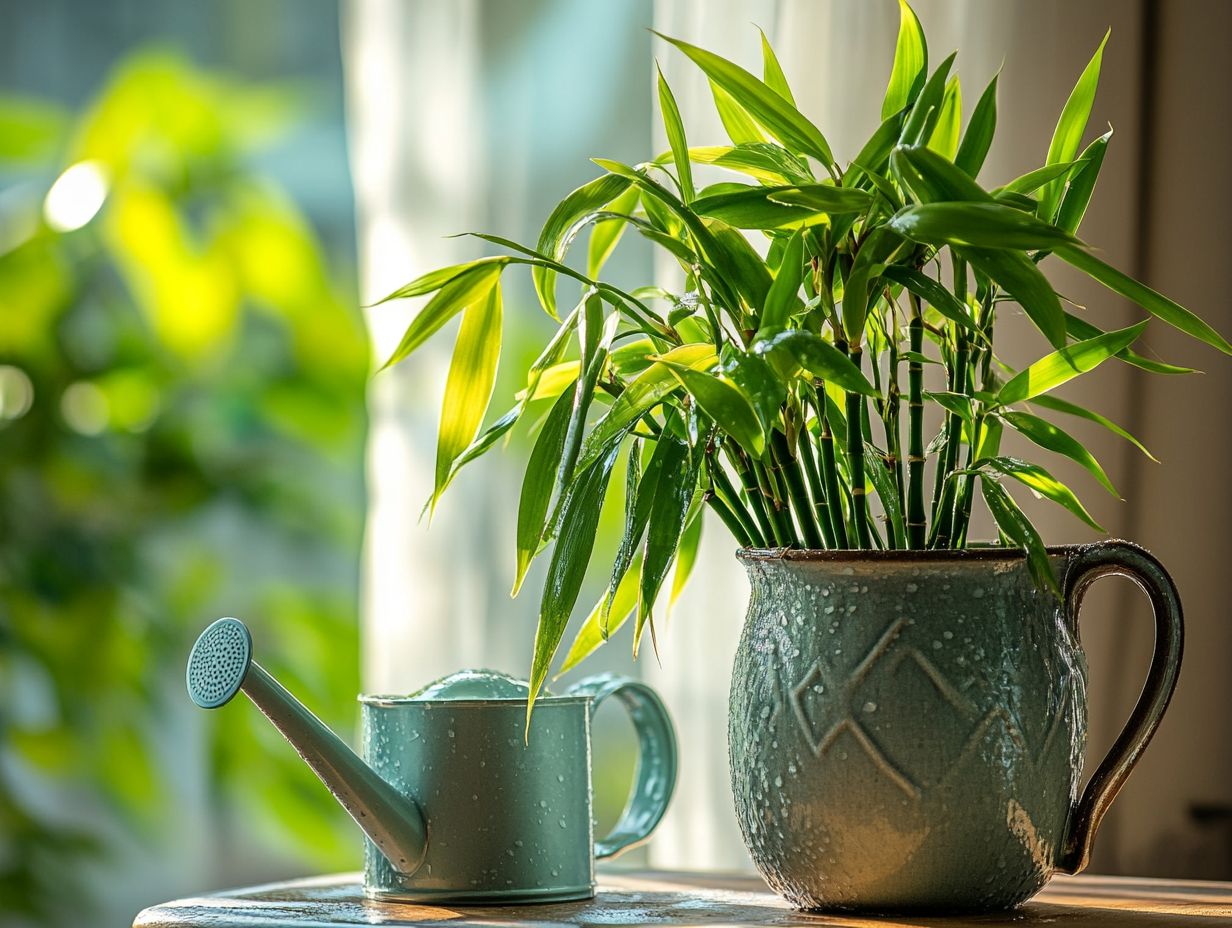
- Choose the right location for your indoor bamboo, considering its light and temperature requirements for healthy growth. This plant is known for its fast growth and low maintenance nature.
- Proper watering and fertilizing techniques, such as using a diluted liquid fertilizer, are crucial for maintaining the health and longevity of indoor bamboo.
- Maintain the aesthetic appeal of your indoor bamboo through regular pruning and shaping to create eye-catching shapes. Be prepared for common pest and disease issues.
Types of Indoor Bamboo
When exploring the various types of indoor bamboo, it s important to understand that the term ‘bamboo’ often points specifically to Lucky Bamboo, or Dracaena sanderiana. This type of Dracaena belongs to the Asparagaceae family, known for its easy care.
This beloved houseplant is known for its easy care and striking visual charm, making it a preferred option for both novice and seasoned gardeners.
Its association with good luck represents happiness, wealth, and long life. This connection is tied to Chinese traditions, further elevating its status as an exceptional choice for indoor greenery and good feng shui.
Choosing the Right Location
Selecting the perfect spot for your Lucky Bamboo is essential to its health and vitality. This plant thrives in environments that promote balance and calm in your home, aligning with feng shui principles.
By carefully considering its placement, you can create an atmosphere that benefits the bamboo and enhances the overall energy of your surroundings.
Light and Temperature Requirements
Lucky bamboo thrives when you provide it with the right light and temperature conditions. It favors bright, indirect sunlight and a climate that mirrors its native African habitat.
This remarkable plant truly thrives in well-lit spaces with filtered light. Direct sunlight can scorch its delicate leaves, showcasing its exquisite growth and health. Ideally, you’ll want to keep temperatures between 65 F and 90 F, creating a cozy environment that encourages growth.
If it doesn t receive adequate lighting, you might notice stunted growth, yellowing leaves, and an overall lackluster appearance. Temperature fluctuations, particularly those that dip below the recommended range, can induce stress, causing it to wilt or become more vulnerable to pests and diseases.
By maintaining these optimal conditions, you ll ensure vibrant, healthy foliage and a steady growth rate.
Watering and Fertilizing
Watering and fertilizing are essential for your Lucky Bamboo. This plant is low maintenance but requires careful attention to watering and nutrients to thrive.
Proper Techniques for Healthy Growth
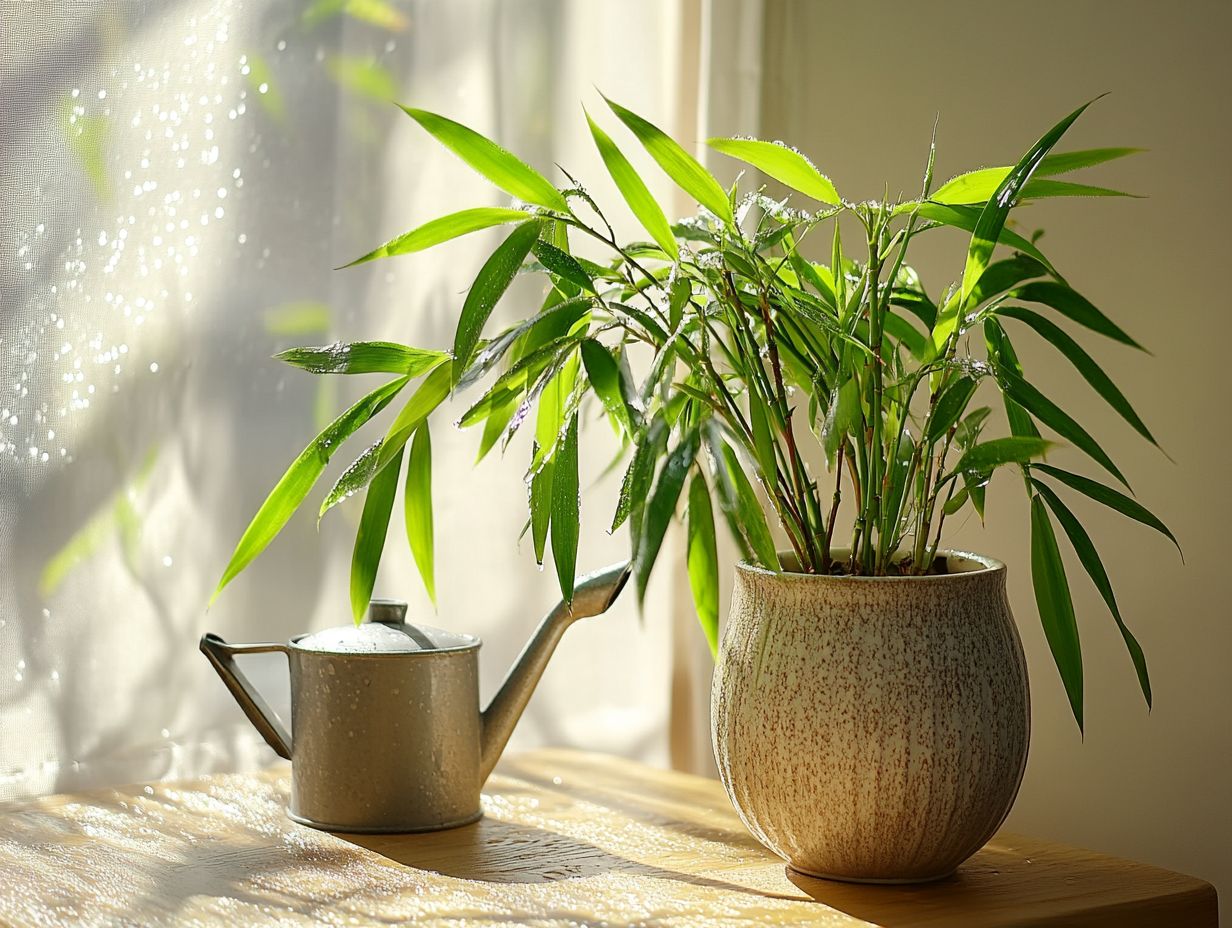
Employing the right propagation techniques for nurturing your lucky bamboo is crucial for its healthy growth and vitality.
Understanding how to propagate this resilient plant through cuttings will significantly enhance its longevity and lushness.
When you propagate lucky bamboo, ensure you select healthy stalks, ideally around six inches long, as they represent balance and harmony.
Ensure at least one node is submerged in water.
To promote robust root development, place the cuttings in an environment with bright, indirect light.
Keep a close eye on their water levels. Maintaining stable moisture reduces stress and encourages growth.
Using clean water and a diluted liquid fertilizer will nourish your plant, helping it flourish into a stunning centerpiece in your home or office.
Pruning and Shaping
Pruning and shaping your lucky bamboo create captivating forms.
This nurturing touch promotes healthy growth and transforms it into a stunning focal point.
Maintaining Aesthetic Appeal
Want your lucky bamboo to flourish? Regular pruning and shaping can help!
To maintain its aesthetic appeal, it’s essential to employ effective shaping techniques.
These techniques ensure the plant continues to embody balance and harmony within your living space, contributing to good feng shui.
These techniques can transform a simple arrangement into a captivating focal point, effortlessly drawing the eye and elevating the overall atmosphere.
For instance, by intertwining the stalks in unique arrangements, you can introduce a sense of dynamism.
Placing your bamboo in decorative pots or vases filled with stones enhances its natural elegance.
Thoughtful placements enhance visual interest. They also align with feng shui principles to promote positive energy.
Integrating lucky bamboo with elements such as candles or natural light sources contributes to a serene ambiance.
Pest and Disease Management
Managing pests and diseases is key to keeping your lucky bamboo healthy.
Use neem oil for spider mites to protect your plant.
Act quickly to resolve issues like spider mites before they spread and harm your plant.
Prioritizing these practices ensures your lucky bamboo remains a vibrant and thriving addition to your space.
Common Issues and Solutions
Identifying common issues with lucky bamboo, such as yellowing leaves or stunted growth, gives you the power to implement effective solutions.
For instance, if you notice yellowing leaves, it might be a sign of overwatering or insufficient light.
This can prompt you to adjust your watering schedule or consider moving your lucky bamboo to a brighter spot.
Stunted growth, on the other hand, often points to nutrient deficiencies or an inadequate pot size.
A balanced fertilizer is a type of fertilizer that contains equal parts of essential nutrients.
In this case, adding a balanced fertilizer could rejuvenate your plant.
Opting for a larger container might offer the necessary space for it to thrive.
By recognizing these signs early and applying the appropriate care strategies, you can promote the longevity of your lucky bamboo.
This also enhances its stunning appearance, creating a vibrant indoor environment filled with good health and happiness.
Repotting and Transplanting
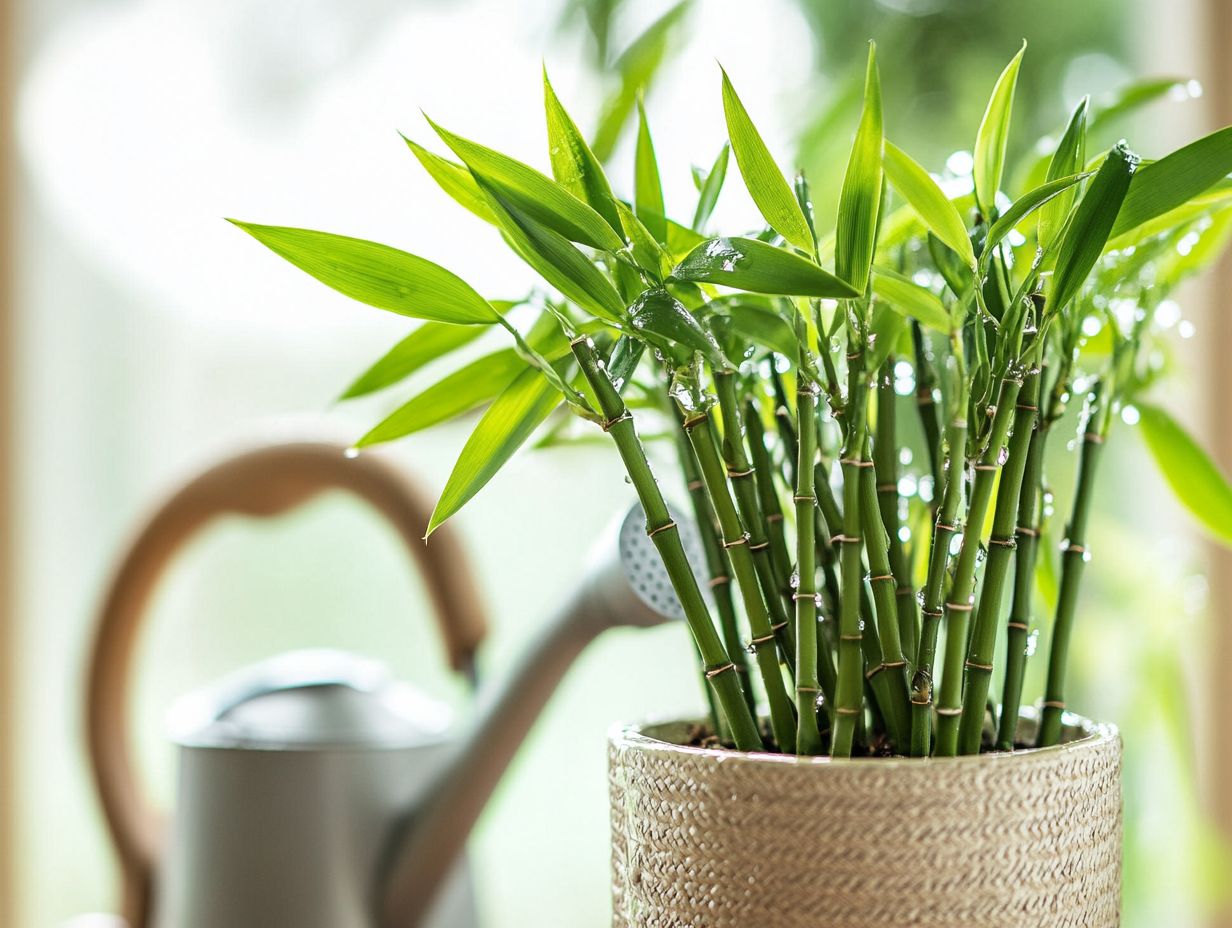
Repotting and transplanting lucky bamboo are crucial practices for sustaining its growth and vitality.
These practices ensure that this exquisite plant continues to thrive as a stunning addition to your indoor space.
When and How to Repot
Knowing when and how to repot your Lucky Bamboo is crucial for nurturing its healthy growth. This ensures it flourishes as an easy-to-care-for plant.
Several signs indicate that this resilient plant may need a change of scenery. For instance, if you notice the roots becoming densely packed and circling the pot or if the plant appears stunted with yellowing leaves, it s likely time for a repotting.
If you frequently find the water level running low, that could hint at root crowding. When you’re ready to repot, choose a new pot that s slightly larger than the current one, providing enough room for growth without overwhelming your plant.
Lastly, using well-draining potting soil is essential for maintaining the moisture balance needed for optimal health. This supports vibrant green leaves and encourages robust growth, allowing for a stunning home display.
Tips for Long-Term Care
By implementing effective strategies for the long-term care of your Lucky Bamboo, you can ensure its robust health and rapid growth. This will allow it to thrive as a cherished indoor companion.
Ensuring the Health and Longevity of Indoor Bamboo
Ensuring the health and longevity of your Lucky Bamboo a wonderfully low-maintenance plant requires your attentive care and commitment to best practices throughout its life cycle.
This includes finding the perfect balance when it comes to watering and ensuring it receives sufficient nutrients. Opt for distilled or filtered water to prevent chemical buildup. Be mindful of the light conditions, too.
Your Lucky Bamboo will thrive with adequate light, but avoid direct sunlight, as it can scorch the leaves. Fertilizing every couple of months with a diluted liquid fertilizer mix the fertilizer with water to make it less concentrated can give it a boost.
Remember, moderation is key; overfeeding can do more harm than good. Pay attention to environmental factors as well. Avoid cold drafts and maintain a warm, humid atmosphere for your plant’s well-being.
By embracing these specific care practices, you can help your Lucky Bamboo flourish. Showcase its vibrant green stalks and fresh leaves as it symbolizes love and happiness.
Frequently Asked Questions
-
What is the best way to water indoor bamboo to ensure it remains a low-maintenance, thriving plant that embodies happiness and good luck?
Water indoor bamboo once a week, ensuring the soil is evenly moist. Avoid overwatering to prevent root rot.
-
Does indoor bamboo need direct sunlight?
No, indoor bamboo thrives in bright, indirect light. Direct sunlight can scorch the leaves.
-
How often should I fertilize my indoor bamboo?
Fertilize indoor bamboo once every two months during the growing season with a balanced fertilizer. Do not fertilize during the winter months.
-
Can I trim my indoor bamboo?
Yes, you can trim indoor bamboo to control its size or to remove any dead or damaged leaves. Use clean, sharp scissors to avoid damaging the plant.
-
What temperature is best for indoor bamboo?
Indoor bamboo prefers temperatures between 65-90 F (18-32 C). Avoid placing it near drafts or vents to prevent temperature fluctuations.
-
Should I repot my indoor bamboo?
Repot indoor bamboo every 2-3 years in a pot 1-2 inches larger in diameter. Use a well-draining soil mix and gently loosen the roots before repotting.
Start your bamboo care journey today for a happier, healthier plant!


